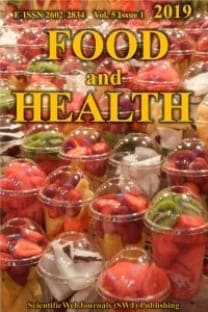Effects of different types of herbs on colour and texture properties of Kashar cheese
___
Ahmed, A.,K., Johnson., K.,A. (2000). Horticultural development of Australian native edible plants. Australian Journal of Botany, 48, 417-426. https://doi.org/10.1071/BT99042Agboola, S.O., Radovanovic-Tesic, M. (2002). Influence of Australian native herbs on the maturation of vacuumpacked cheese. LWT-Food Science and Technology 35, 575-583. https://doi.org/10.1016/S0023-6438(02)90917-5
Antoniou, K.D., Petrides, D., Raphaedlides, S., Ben Omar, Z. and Kesteloot, R. (2000). Texture assessment of French cheeses, Journal of Food Science, 65, 168-172. https://doi.org/10.1111/j.1365-2621.2000.tb15974.x
Çakır, S. (2018). Antioksidan aktiviteye sahip bazı baharatların taze kaşar peynirinde kullanımı. Yüksek lisans Tezi, Manisa Celal Bayar Üniversitesi, Fen Bilimleri Enstitüsü, Gıda Mühendisliği Anabilim Dalı, Manisa.
Cavalier-Salou, C., Cheftel, J.C. (1991). Emulsifying salts influence on characteristics of cheese analogs from calcium caseinate, Journal of Food Science, 56, 1542-1547. https://doi.org/10.1111/j.1365-2621.1991.tb08636.x
Emmons, D.B., Kalab M., Larmond E., Lowrie R.J. (1980). Milk gel structure,10,Texture and microstructure in Kashar cheese made from whole milk and from homogenized low fat milk, Journal of Texture Studies, 11, 15-34. https://doi.org/10.1111/j.1745-4603.1980.tb00305.x
Everard, C., O'callaghan, D., Howard, T., O'donnell, C., Sheehan, E., Delahunty, C. (2006). Relationships between sensory and rheological measurements of texture in maturing commercial Kashar cheese over a range of moisture and pH at the point of manufacture. Journal of Texture Studies, 37, 361-382. https://doi.org/10.1111/j.1745-4603.2006.00057.x
Fırat, N. (2006). Çiğ ve pastörize sütten üretilen Kaşar peynirlerinin olgunlaşma süresince bazı mikrobiyolojik, fiziksel ve kimyasal özelliklerinin belirlenmesi. Yüksek Lisans Tezi, Atatürk Üniversitesi Fen Bilimleri Enstitüsü, Gıda Mühendisliği Anabilim Dalı, Erzurum.
Gunasekaran, S., Ak, M.M. (2003). Cheese reology and texture, CRC Press, Boca Raton, Florida. https://doi.org/10.1201/9781420031942
Gülter, S. (2011). Dondurarak kurutulan Kaşar peyniri tozlarının özellikleri üzerine peynirin üretim yönteminin, yağ oranın ve olgunluğunun depolama sürecindeki etkileri. Yüksek Lisan Tezi. Çukurova Üniversitesi, Fen Bilimleri Enstitüsü, Gıda Mühendisliği Anabilim Dalı, Adana.
Hayaloğlu, A.A., Fox, P.F. (2008). Cheeses of Turkey: 3. Varieties containing herbs or spices. Dairy Science and Technology, 88, 245-256. https://doi.org/10.1051/dst:2007015
Keceli, T., Sahan, N., Yasar, K. (2006). The effect of preacidification with citric acid on reduced-fat kashar cheese. Australian Journal of Dairy Technology, 61, 32-36.
Koca, N., Metin, M. (2004). Textural, melting and sensory properties of low-fat fresh kashar cheeses produced by using fat replacers. International Dairy Journal, 14, 365-373. https://doi.org/10.1016/j.idairyj.2003.08.006
Öksüz, Ö., Kurultay, S., Şimşek, O. (2001). The Effect of Brevibacterium Linens on Some Physico-Chemical Properties and Colour Intensity of Kashar Cheese. Milchwissenschaft, 56, 82-85.
Sood, S.M., Gaind, D.K., Dewan, R.K. (1979). Correlation between micelle solvation and calcium content, Journal of Dairy Science and Technology, 14, 32-34.
Tarakcı, Z., Coskun, H., Tuncturk, Y. (2004). Some properties of fresh and ripened herby cheese, a traditional variety produced in Turkey. Food Technology and Biotechnology, 42, 47-50.
Tarakçı, Z., Durmaz, H., Sağun, E. (2005). Siyabonun (Ferula sp.) otlu peynirin olgunlaşması üzerine etkisi. Tarım Bilimleri Dergisi, 15, 53-56.
Tarakçı, Z., Küçüköner, E. (2006). Changes on physicochemical, lipolysis and proteolysis of vacuum-packed turkish kashar cheese during ripening. Journal of Central European Agriculture, 7, 459-464.
Tarakçı, Z., Akyüz, N. (2009). Effects of packaging materials and filling methods on selected characteristics of Otlu (Herby) cheese. International Journal of Food Properties, 12, 496-511. https://doi.org/10.1080/10942910701813941
Tarakçı, Z., Temiz, H. (2009). A review of the chemical, biochemical and antimicrobial aspects of Turkish Otlu (herby) cheese. International Journal of Dairy Technology, 62, 354-360. https://doi.org/10.1111/j.1471-0307.2009.00495.x
Tarakçı, Z., Deveci, F. (2019). The effects of different spices on chemical, biochemical, textural and sensory properties of White cheeses during ripening. Mljekarstvo, 69, 64-77. https://doi.org/10.15567/mljekarstvo.2019.0106
Tarakçı, Z., Temiz, H., Ugur, A. (2011). The effect of adding herbs to labneh on physicochemical and organoleptic quality during storage. Intational Journal of Dairy Technology, 64, 108-116. https://doi.org/10.1111/j.1471-0307.2010.00636.x
Voss, D.H. (1992). Relating Colorimeter Measurement of Plant Color to the Royal Horticultural Society Colour Chart. Hortscience, 27, 1256-1260. https://doi.org/10.21273/HORTSCI.27.12.1256
Yaşar, K., Güzeler, N. (2011). Effect of coagulant type on the physicochemical and organoleptic properties of Kashar cheese. International Journal of Dairy Technology, 64, 372- 379. https://doi.org/10.1111/j.1471-0307.2011.00679.x
- ISSN: 2602-2834
- Yayın Aralığı: 4
- Başlangıç: 2018
- Yayıncı: ScientificWebJournals (SWJ) Özkan Özden
Sürülebilir keçiboynuzu kreması formülasyonunun karışım deseni ile optimizasyonu
Kepek katkılı ekstrüde mısır çerezinin besleyicilik ve fonksiyonel özelliklerinin araştırılması
NAZLI ŞAHİN, Nermin BİLGİÇLİ, ABDULVAHİT SAYASLAN
A1 milk and beta-casomorphin-7
Seval ANDİÇ, Rozelin Münevver AYAZ, Şehriban OĞUZ
Et ve et ürünlerinin üretimi ve saklanmasında antimikrobiyal ambalajlama sistemlerinin kullanımı
Yasemin ÇELEBİ SEZER, HÜSEYİN BOZKURT
Effects of different types of herbs on colour and texture properties of Kashar cheese
